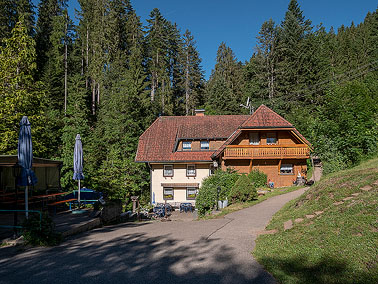
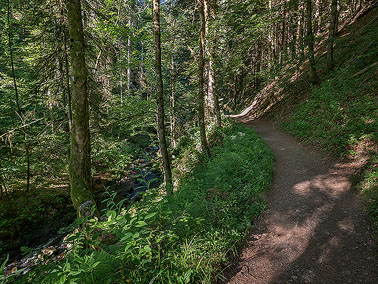


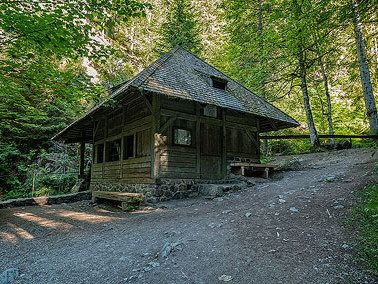
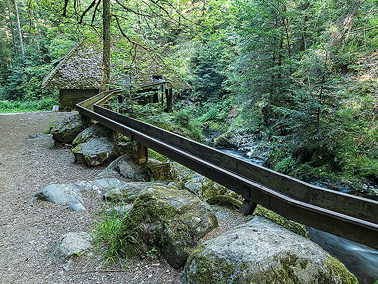
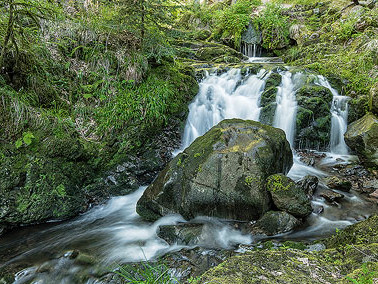
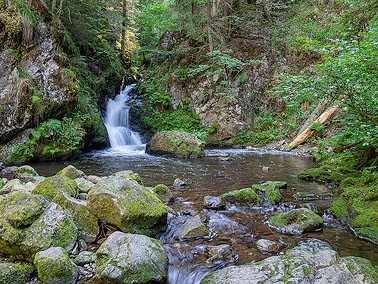
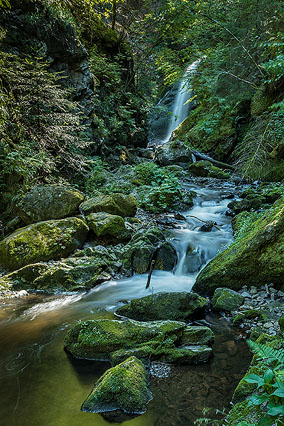
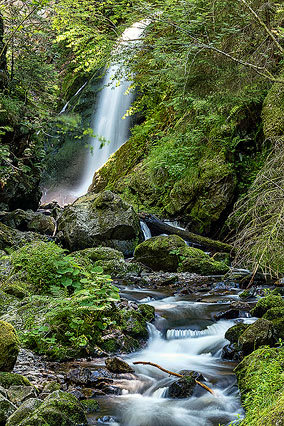

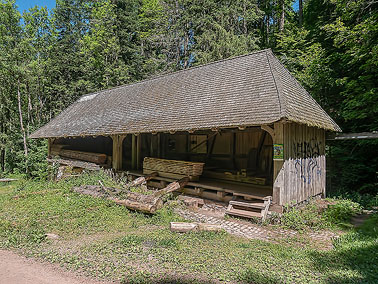
| G3VGR | Hochschwarzwald - Ravennaschlucht |
After the mill, the scenery gets wilder and the path gets narrower and more exposed as it follows the Ravennabach which is now noisily crashing over boulders. I was now in the narrowest part of the gorge under towering cliffs and a green canopy formed by the trees and soon passed the Kleiner Ravennafall with its 6 metre drop. This was great walking and I had not yet met any other hikers so was able to enjoy the scenery with no distractions. Further on, I reached the Große Ravennafall. This impressive waterfall has a 16 metre drop and is the highlight of the Ravennaschlucht. The path led down steep steel steps alongside the falls and I was able to walk back along the stream from the bottom of the steps to gain a better view. After taking some photos, I clambered back over rocks to the base of the steps where the peace of my quiet morning was immediately shattered. There was a horde of around 50 American tourists, most of whom were wearing inappropriate footwear, making their way up the narrow duckboards towards the waterfall. Obviously some tour buses had stopped at the bottom of the ravine and pointed their visitors in the direction of the waterfall. Unfortunately, they seemed to have been allowed little time and although I recommended they make their way to both the Großjockenmühle and Kleine Ravennafall, they almost immediately made their way back down the gorge. From the Grosse Ravennafall, it is just a short walk to the end of the Ravennaschlucht.The Ravennaschlucht was as beautiful as I remembered and I was pleased to have walked it again As I exited the gorge, I passed the Galgenbühl, a 30m high mound which in bygone times featured a gallows and was used as an execution site, then walked under the 58m high Ravennabrücke, the viaduct of the Höllentalbahn. A Christmas market takes place on the Advent weekends under the illuminated viaduct. I was now at Hofgut Sternen, a major tourist trap of the Höllental, with shops selling cuckoo clocks, demonstrations of glass blowing and how to make Schwarzwälder Kirschentorte. I stopped for a coffee at the Hotel Hofgut Sternen. The whole area was extremely busy and quite a few tour buses were parked there. As part of her bridal journey from Vienna to Versailles , Marie-Antoinette is said to have stopped in the Hofgut Sternen in 1770. Johann Wolfgang von Goethe also stayed there in 1779. Away from the main tourist area is Saint Oswald�s Chapel (built 1148), but I didn't visit it on this trip due to it being very busy with many tourists.
Leaving Hofgut Sternen, I crossed the busy B31 through an underpass and arrived in the Löffeltal. The Löffeltal is a nearly 3 km long valley section of the Rotbach between Hinterzarten and Höllsteig. The name "Löffeltal" (literally "Spoon Valley") goes back to the presence of some spoon forges, powered by the Rotbach. It gave the valley section in the 19th century great economic importance and a forge could produce 40 spoons a day. I made my way up the Löffeltalweg, a broad road leading to Hinterzarten. Along the way were reminders of its industrial past. Most impressive was the Kingenhofsäge, a knocking saw from 1828 and powered by water from the Rotbach which was used to cut tree trunks lengthwise into thick planks. The Kingenhofsäge has been restored and is functional. I saw a man positioning a tree trunk ready for cutting, but I assume, like the Großjockenmühle, this would only be operational for visitors on a Sunday Further along the Löffeltalweg, I passed the Löffelmühle and the Hirschenmühle, two more spoon forges, before arriving back in Hinterzarten at lunchtime. As I was still very tired from yesterday and had no energy whatsoever, I discounted any thoughts of more hikes today and instead took the train to Freiburg. The Altstadt streets were very busy as everyone was out enjoying the summer weather. However the temperature there was over 40C, so I didn't feel too active. In the evening I enjoyed a schnitzel at the Hausbrauerei Feierling, accompanied by their excellent Inselhopf beer before returning to Hinterzarten.

Haus Ketterer
|

Start of the Ravennaschlucht trail
|

Slow moving Ravennabach
|

Along the Ravennaschlucht
|

Großjockenmühle
|

Water supply to power the mill's wheel
|

Waterfall by the Großjockenmühle
|

Kleine Ravennafall
|

Grosse Ravennafall
|

Grosse Ravennafall
|
|
|
|

Along the Löffeltalweg
|

Kingenhofsäge, a restored sawmill
|